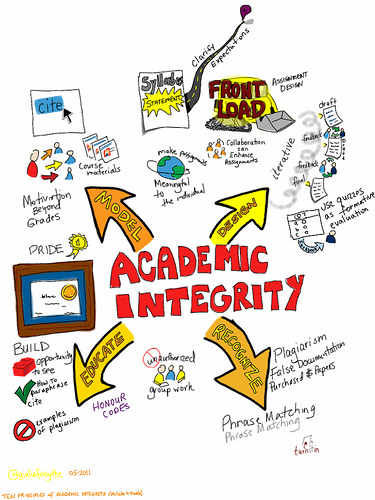Hunter faculty have access to two plagiarism prevention tools: SafeAssign, which is integrated into Blackboard, and Turnitin, which (for now) is a standalone tool. While these tools can be used to detect plagiarism after the fact, they can also be used to teach students about academic integrity and proper citation of sources. Whether you’re thinking about using one of these tools, or are already an active user, here are some questions you might want to consider.
Discussing academic integrity and plagiarism with your students
The concept of academic integrity can be introduced at the beginning of the semester and woven into discussions throughout the semester. It is important to help students understand the idea of intellectual property, and how academic integrity affects the College and their own lives. Sharing real-world examples will help to illustrate the importance of academic integrity.
How will you introduce the idea of plagiarism and academic integrity?
 The way in which academic integrity is initially introduced will set the tone for the rest of the semester.
The way in which academic integrity is initially introduced will set the tone for the rest of the semester.
- Let your students know early in the semester if you plan to use plagiarism prevention tools, such as Turnitin or SafeAssign.
- Include Hunter’s academic integrity policy statement in your syllabus.
- Broaden the discussion beyond policy – discuss the concept of academic integrity as it relates to pedagogy, rhetorical processes, and research.
How can you use plagiarism prevention tools to teach writing and research skills?
Plagiarism prevention tools can be used for more than policing. Here are some ideas:
- Create opportunities for learning by presenting examples of well-documented papers and improperly cited or paraphrased passages.
- Generate sample originality reports and discuss your interpretation with the class.
- Allow students to see originality reports generated from their own papers and use them as self-assessment tools.
Tool-related Considerations
As a faculty member, you have many options about how to use the tools available to you. Here are some things to think about up front:
How will student papers be submitted?
Both Turnitin and SafeAssign provide options for faculty or student submission of papers. If you routinely use these tools, you can set up an assignment within the tool and ask students to upload their papers. If you use the tools only for papers in which you suspect plagiarism, you can upload selected student papers or specific sections of student papers.
How will you address copyright and privacy issues as they relate to student work?
Depending on the options chosen, papers submitted to Turnitin or SafeAssign may be added to a database that can be used by other faculty, including faculty outside of Hunter. Submitting a student paper to such a database allows future searches against that paper, but it also raises questions about student privacy. Although faculty can view only their own students’ papers in their entirety, they may have access to portions of other student papers if a match is found. Here are some steps that can be taken to protect student privacy:
- Ask students to eliminate all personal information in the body of the paper before submitting it to Turnitin or SafeAssign.
- If you are contacted by another instructor who suspects a student of copying one of your student’s papers, keep your student’s identity confidential when sharing the content of the paper.
- Do not submit creative/original works by students (e.g., poetry, short stories, memoirs). If you suspect plagiarism, you can upload specific sections without submitting the entire paper.
How will you will use the originality report generated by these tools?
Both Turnitin and SafeAssign produce an originality report that indicates which parts of a paper match other sources to which the paper was compared. The report includes a “similarity index” showing the overall percentage of the submitted text for which matches were found. The originality report is not, by itself, evidence of plagiarism, but may also provide useful information about whether a student used and cited sources appropriately.
Keep in mind that:
- A high similarity index does not necessarily indicate plagiarism; it may instead suggest that a student has included a large number of properly cited citations or quoted passages, rather than including a substantial amount of his/her own analysis.
- A low similarity index may indicate that a paper was not properly researched or cited. A student may have paraphrased content without including the appropriate citations or may have neglected to draw on a significant number of sources for their analysis.
Additional Considerations
What else can you do to discourage plagiarism?
Of course, technology is not the only way to combat plagiarism. Writing Across the Curriculum staff and writing fellows can help you develop writing assignments, assessment options, and writing-to-learn activities. A few ideas are below:
- Devise unique and focused assignments.
- Place more emphasis on the writing and research process by requesting submissions of an outline or a thesis proposal, an annotated bibliography, and multiple drafts before the final draft is due.
- Create a “low-stakes” assignment early in the semester to obtain a writing sample for future comparison. Use the assignment to refer students to Hunter’s Reading/Writing Center, as appropriate.
What should you do if you suspect plagiarism?
- Refer to these guidelines from Hunter’s Office of Advising Services.
Where can you get additional help at Hunter?
- Writing Across the Curriculum staff and writing fellows can help you develop writing assignments, assessment options, and writing-to-learn activities.
- The Hunter Library Information Literacy Commons has resources on using information responsibly.
- The Technology Resource Center (TRC) can help you get started with Turnitin and SafeAssign.
Image credit: Academic Integrity by Giulia Forsythe. Used under a Creative Commons Attribution-NonCommercial-ShareAlike 2.0 Generic License.



Comments are closed.